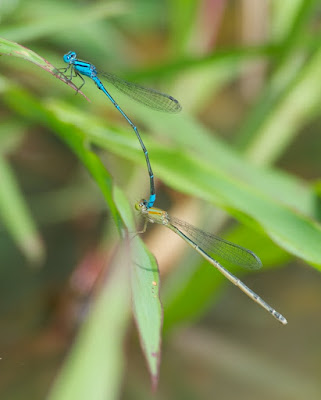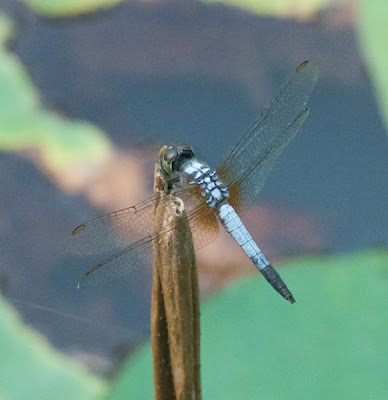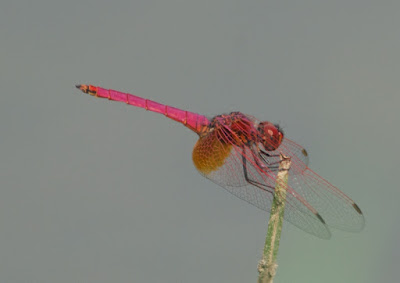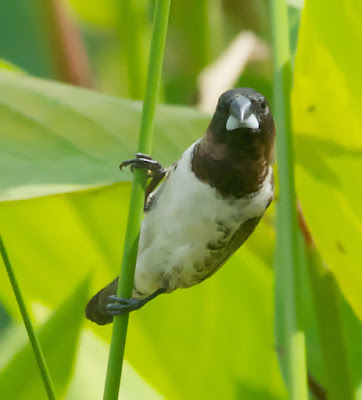Sacred Lotus (Nelumbo nucifera) is a fascinating plant, and not just because of its religious associations (not to mention it's tasty seeds and roots). It looks like a particularly glamorous water lily (Nymphaeaceae), and for a long time that is what botanists thought it was. Molecular research, however, has revealed that its closest relatives are in fact sycamore or plane trees (Platanaceae) and the members of the fascinating Southern Hemisphere family Proteaceae.
The restored river is home to a number of fishes, but the ones I saw were not native to Singapore. This African sharp-toothed walking catfish (Clarias gariepinus) earns its name from its ability to slither overland from one body of water to another.
The Mayan cichlid (Cichlasoma urophthalmum), as it's name implies, hails from Central America. A visitor today might not see so many fish in th park; since my visit there have been massive fish die-offs in the river, for reasons that have yet to be determined (rising water temperatures? Pollution? No one knows).
Even the snails are not native. These clumps of Golden Apple Snail eggs (Pomacea canaliculata) really ought to be decorating a bollard in Florida.
Around the lotus ponds I found stands of a flowering arum (Calla palustris?), the pungent aroma of their flowering stalks attracting crowds of hoverflies (possibly Graptomyza sp).
A park with as much flowing and standing water as Bishan is bound to attract dragonflies and damselflies (my chief reason for going there). This is the abundant damselfly Pseudagrion microcephalum.
There are two very similar Pseudagrion damselflies in Singapore, microcephalum and the considerably rarer australasiae, the so-called Look-alike Sprite. Both are supposedly at Bishan. The males are extremely difficult to identify, but the females are quite different from each other. Mated pairs, therefore, provide a useful way to identify both sexes. These, unfortunately, are the common microcephalum. Either I never did find australasiae, or the damsels of that species just weren't in the mood that day - so I couldn't be sure of their males' identity.
Considerably easier to identify was Ischnura senegalensis, a common and wide-ranging member of the forktail group (as its name implies, it is also widespread in Africa).
I found a number of common dragonflies in the park, including the ubiquitous Neurothemis fluctuans...
Considerably easier to identify was Ischnura senegalensis, a common and wide-ranging member of the forktail group (as its name implies, it is also widespread in Africa).
I found a number of common dragonflies in the park, including the ubiquitous Neurothemis fluctuans...
... And the equally unavoidable Orthetrum sabina.
Here is an attractively pruinose male Diplacodes trivialis...
...the commonest of the blue dragonflies, Brachydiplax chalybea...
...and, for contrast, a brilliant red male Crocothemis servilia.
The female Crocothemis is considerably subtler than the male.
These females gave me some pause, but they are, it appears, Trithemis aurora, whose males are far more spectacular....
....as this day-glo pink individual amply demonstrates.
This male appeared to have developed a fascination for a clump of apple snail eggs, to which he kept returning. I have no idea what the attraction was, because I don't believe dragonflies, which are active airborne predators, are properly equipped to eat such things.
Besides the dragonflies, the pondside vegetation attracted a numbers of estrildid finches on the hunt for grass seeds. They included a common native species, the Scaly-breasted Munia (Lonchura punctulata).
More interesting to me were a number of puzzling birds that were either Javan Munias (Lonchura leucogastroides), an introduced species now much less common in Singapore than it was in the last century, or White-bellied Munias (Lonchura leucogastra), a species formerly unknown in Singapore that has apparently colonized the island from further north in Malaysia (with or without the help of escaped cage birds) in recent decades.
The problem is that the guidebooks seem to differ on what the field marks of these two species actually are, and these birds appear to show characteristics of both: the more extensive white belly and plain back (without white shaft-streaks) of the Javan, and the barred or mottled flanks (as opposed to clean white) of the White-bellied. Is it possible that these two birds, both outside their original ranges in Singapore, are hybridizing there?




































No comments:
Post a Comment